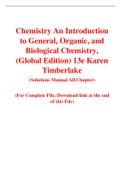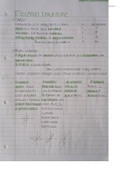Chemistry An Introduction to General, Organic, and Biological Chemistry, (Global Edition) 13e Karen Timberlake (Solutions Manual All Chapter ) (For Complete File, Download link at the end of this File) 1
1
Chemistry in Our Lives
Learning Goals
• Define the term chemistry and identify substances as chemicals.
• Describe the acti
vities tha
t ar
e part of the scientific method.
•
Identify str
ategies tha
t ar
e ef
fective f
or learning. De
velop a stud
y plan f
or learning chemistry
.
• Review ma
th concepts used in chemistry: place v
alues, positi
ve and nega
tive n
umbers, percenta
ges, solving equa
tions, and interpr
eting gr
aphs.
• Write a n
umber in scientific nota
tion.
Chapter Outline
Chapter Opener: F
orensic Scientist
1.1 Chemistry and Chemicals
1.2 Scientific Method: Thinking Like a Scientist
Chemistr
y Link to Health: Early Chemist: Paracelsus
1.3 Studying and Lear
ning Chemistry
1.4 Ke
y Math Skills for Chemistry
1.5 Writing Numbers in Scientific NotationClinical Update: F
orensic Evidence Helps Solve the Crime Key Math Skills
• Identifying Place Values 11.42
• Using Positive and Negative Numbers in Calculations 11.42
• Calculating Percentages 11.42
• Solving Equations 11.42
• Interpreting Graphs 11.42
• Writing Numbers in Scientific Notation 11.52
Answers and Solutions to Text Problems
1.1 a. Chemistry is the study of the composition, structure, properties, and reactions of matter.
b.A chemical is a substance that has the same composition and properties wherever it is found.
1.2 Your friends ma
y gi
ve a v
ariety of definitions
, most of w
hich will pr
obably not a
gree with the dictionary definitions
.
1.3 Many chemicals ar
e listed on a vitamin bottle such as vitamin A, vitamin B3, vitamin B12, vitamin C
, and f
olic acid.
1.4 Many chemicals ar
e listed on a cer
eal bo
x such as vitamin A, vitamin B6, vitamin B12, vitamin C
, f
olic acid, sugar
, salt, and ir
on.
M01_TIMB4661_13_IM_C01.indd 1 4/8/17 9:26 PMCopyright © 2019 Pearson Education Ltd . Chapter 1
2
Copyright © 2019 Pearson Education Ltd . 1.5 Typical items found in a medicine cabinet and some of the chemicals they contain are as follows:
Antacid tablets: calcium carbonate, cellulose, starch, stearic acid, silicon dioxide
Mouthwash: water, alcohol, thymol, glycerol, sodium benzoate, benzoic acid
Cough suppressant: menthol, beta-carotene, sucrose, glucose
1.6 a. Typical chemicals found in vinegar are: acetic acid and water. b.Typical chemicals found in alcohol disinfectant pads are isopropyl alcohol or ethanol.
1.7 a. An observation is a description or measurement of a natural phenomenon.
b. A hypothesis proposes a possible explanation for a natural phenomenon.
c. An experiment is a procedure that tests the validity of a hypothesis.
d. An observation is a description or measurement of a natural phenomenon.
e. An observation is a description or measurement of a natural phenomenon.
f. A conclusion is an explanation of an observation that has been validated by repeated
experiments that support a hypothesis.
1.8 a. An observation is a description or measurement of a natural phenomenon.
b. A hypothesis proposes a possible explanation for a natural phenomenon.
c. An experiment is a procedure that tests the validity of a hypothesis.
d. An experiment is a procedure that tests the validity of a hypothesis.
e. An observation is a description or measurement of a natural phenomenon.
f. A hypothesis proposes a possible explanation for a natural phenomenon.
1.9 a. An observation is a description or measurement of a natural phenomenon.
b. A hypothesis proposes a possible explanation for a natural phenomenon.
c. An experiment is a procedure that tests the validity of a hypothesis.
d. An experiment is a procedure that tests the validity of a hypothesis.
1.10 a. A hypothesis proposes a possible explanation for a natural phenomenon.
b. An observation is a description or measurement of a natural phenomenon.
c. An experiment is a procedure that tests the validity of a hypothesis.
d. A conclusion is an explanation of an observation that has been validated by repeated
experiments that support a hypothesis.
1.11 There are several things you can do that will help you successfully learn chemistry, including forming a study group, going to class, asking yourself questions as you read new material in the textbook, working Sample Problems and Study Checks, working Practice Problems and checking Answers, reading the assignment ahead of class, self-testing during and after reading each Section, retesting on new information a few days later, going to the instructor’s office hours, and keeping a problem notebook.
1.12 Three safety precautions you can take while working in the laboratory are:
a.Always wear safety goggles and gloves while working with different chemicals.
b.Ensure the presence of a supervisor who has sufficient experience to handle lab eq uipment.
c.Read the labels on the b
ottle carefully before working on an experiment.
1.13 Ways you can enhance your learning of chemistry include:
b.Read the chapter before the class lecture.
c.Be an active learner during the class lecture.
d.Review key core chemistry skills.
1.14 Ways you can enhance your learning of chemistry include:
a.studying different topics at the same time.
c.attending review sessions.
d.working the problems again after a few days.
e.keeping a problem notebook.
M01_TIMB4661_13_IM_C01.indd 2 4/8/17 9:26 PMa.Work on the Q&A for each section and check the answers at the end. Chemistry in Our Lives
3
1.15 a. The bolded 9 is in the hundredths place.
b.The bolded 6 is in the ones place.
c.The bolded 8 is in the tens place.
1.16 a. The bolded 5 is in the tenths place.
b. The bolded 7 is in the tens place.
c. The bolded 0 is in the hundredths place.
1.17 a. 20 - 1 -102 = 20 + 10 = 30
b.- 6 + 1 -382 = -6 − 38 = −44
c.2 * 1 -72 + 14 = -14 + 14 = 0
1.18 a. -17 - 1 -122 = -17 + 12 = -5
b. c.
6= -13
1.19 a. 20 kg cotton
100 kg material ( wheat and cotton)*100, = 20% cotton
b.total mass = 400 tons of wheat + 100 tons of cotton = 500 tons of material (wheat and
cotton)
c.Both carry an equal percentage of wheat.
1.20 a. 22 boys
35 babies*100, =63, boys
b. total grams of alloy =67 g gold +35 g zinc=102 g of alloy
35 g zinc
102 g alloy*100, =34, zinc
c. total number of coins =15 pennies +14 dimes +6 quarters =35 coins
15 pennies
35 coins*100, =43, pennies
1.21 a. 5a + 10 - 10 = 60 - 10 5a = 50
5a
5=50
5 a = 10 b. a
8= 6 8 aa
8b = 8162 a = 48
1.22 a. 2b+7=b+10 2b+7-7=b+10-7 2b=b+3 2b-b=b-b+3 b=3
M01_TIMB4661_13_IM_C01.indd 3 4/8/17 9:26 PM19 + 1 -862 = 19 - 86 = −67
-78
total mass = 80 kg wheat + 20 kg cotton = 100 kg of material (wheat and cotton)
400 tons wheat
500 tons material (wheat and cotton)*100, = 80% wheat 5a + 10 = 60
Copyright © 2019 Pearson Education Ltd .





